Complete Solutions to Example of chapter ORGANIC CHEMISTRY - SOME BASIC PRINCIPLES & TECHNIOUES of Class 11 book with complete answers and questions
| Class 11 | CHEMISTRY |
| Chapter | ORGANIC CHEMISTRY - SOME BASIC PRINCIPLES & TECHNIOUES |
| DINESH COMPANION CHEMISTRY | Example |
| Number Of Questions | 35 |
| Academic Year | 2023-24 |
How many sigma and pi bonds are present in the following molecules :
`(i) CH_(3)-CH_(3)" "(ii) CH_(3)-OH" "(iii) CH_(2)=CH-C equiv N" "(iv) CH_(2)=C=CH_(2)CH_(3)" "(v) CH equiv C CH=CHCH_(3)`
View SolutionState the nature of hybridisation of each carbon atom in the following compounds ?
`(a) CH_(3)Cl" "(b) (CH_(3))_(2)C=O" "(c) CH_(3)-C equiv N" "(d) H-overset(O)overset("||")(C)-NH_(2)" "(e) CH_(3)-CH=CH-C equiv N`
View SolutionRewire the following formulaes with the help of dash formula and also by bond line notations.
`(i) (CH_(3))_(3)C C_(2)H_(5)" "(ii) CH_(3)overset(O)overset("||")(C)CH_(2)CH(CH_(3))_(2)" "(iii) CH_(3)CH(OH)C_(2)H_(5)" "(iv) (CH_(3))_(3)C CH_(2)CH(CH_(3))_(2)`.
View SolutionWrite the IUPAC names of the following compounds
(i) `{:(CH_(3)-CH-CH-CH_(3)),(" | |"),(" "C_(2)H_(5) " C"_(2)H_(5)):}`
(ii) `(CH_(3))_(3)"CC"_(2)H_(5)`
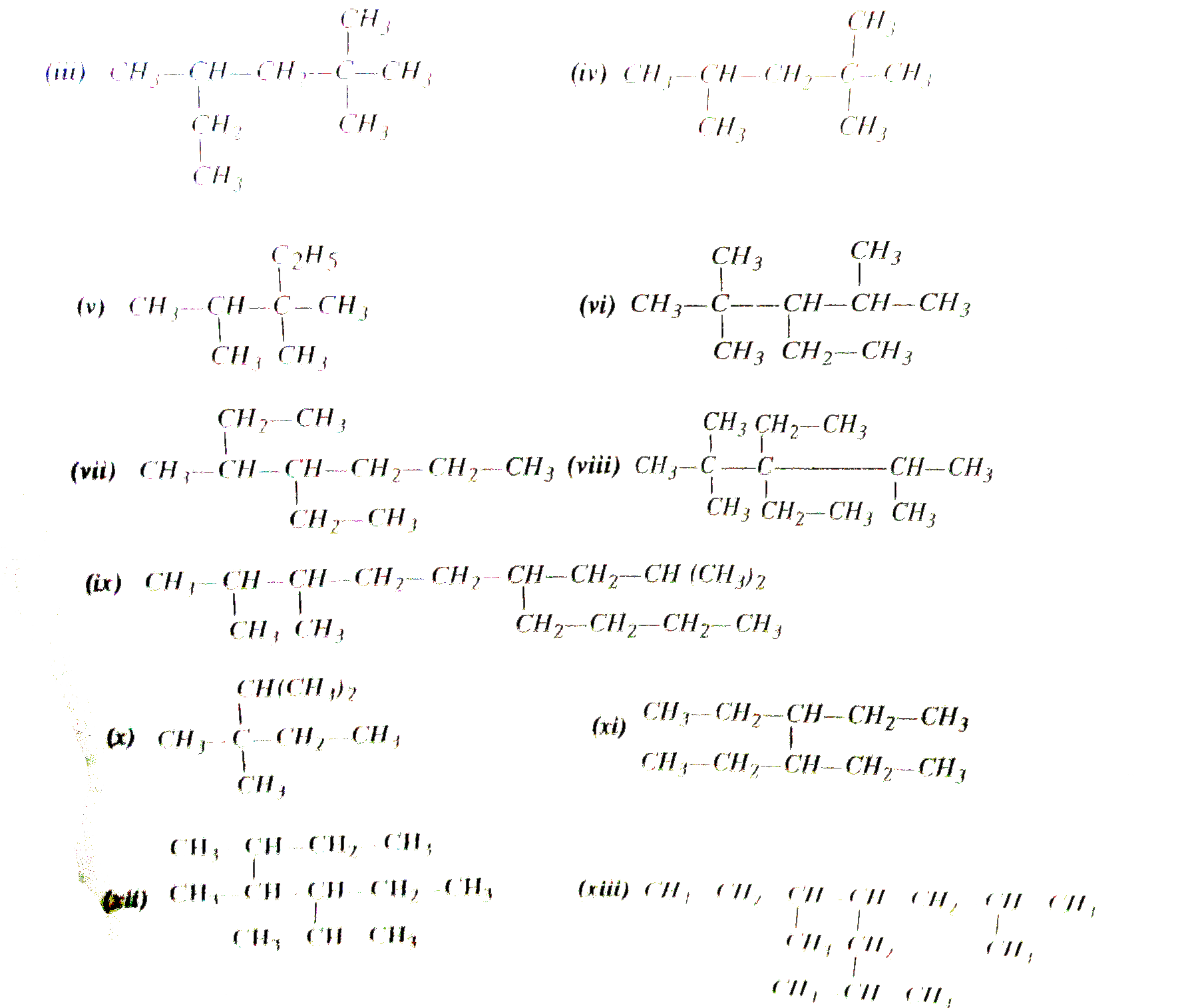
View SolutionWrite the IUPAC names of the following :

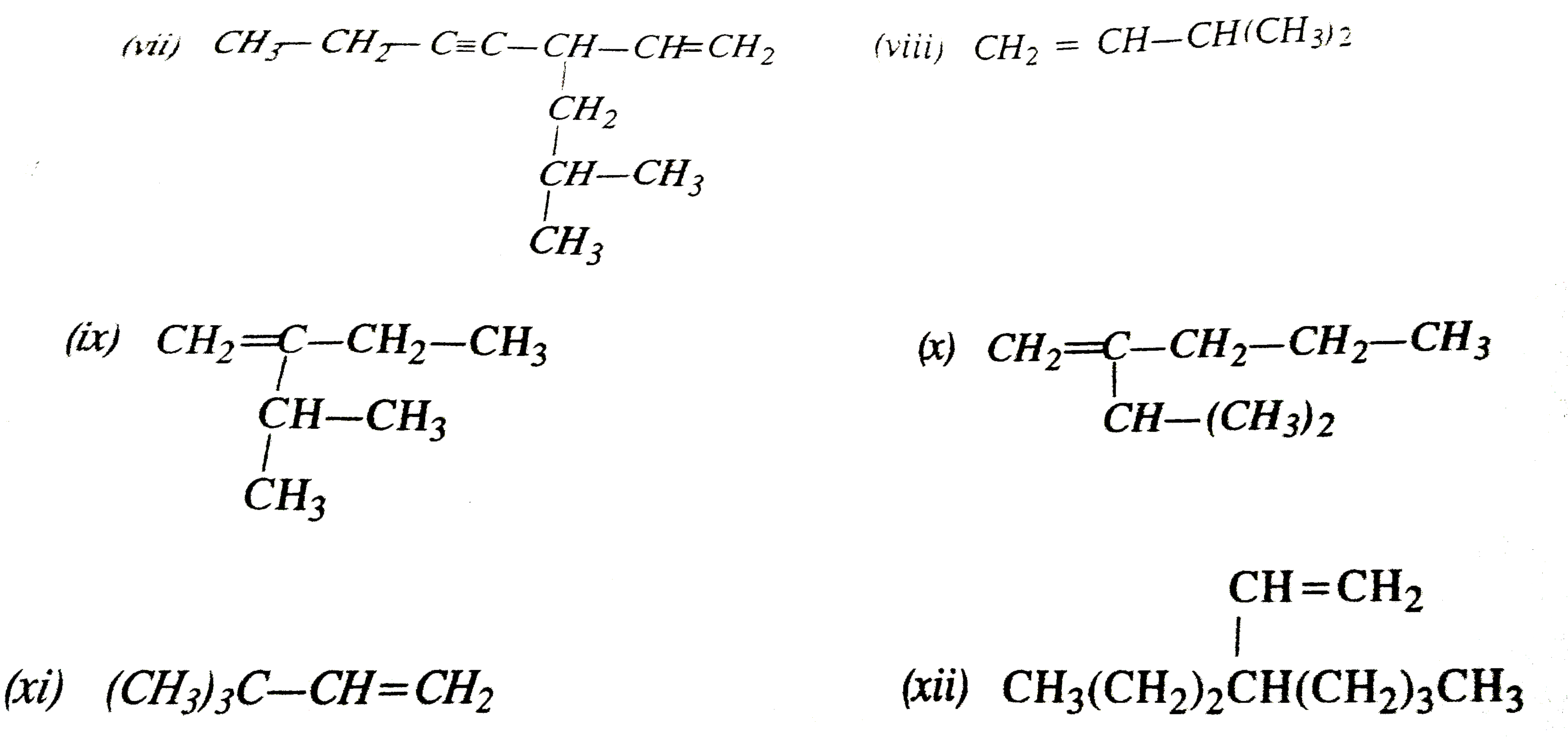
View SolutionWrite the IUPAC names of :
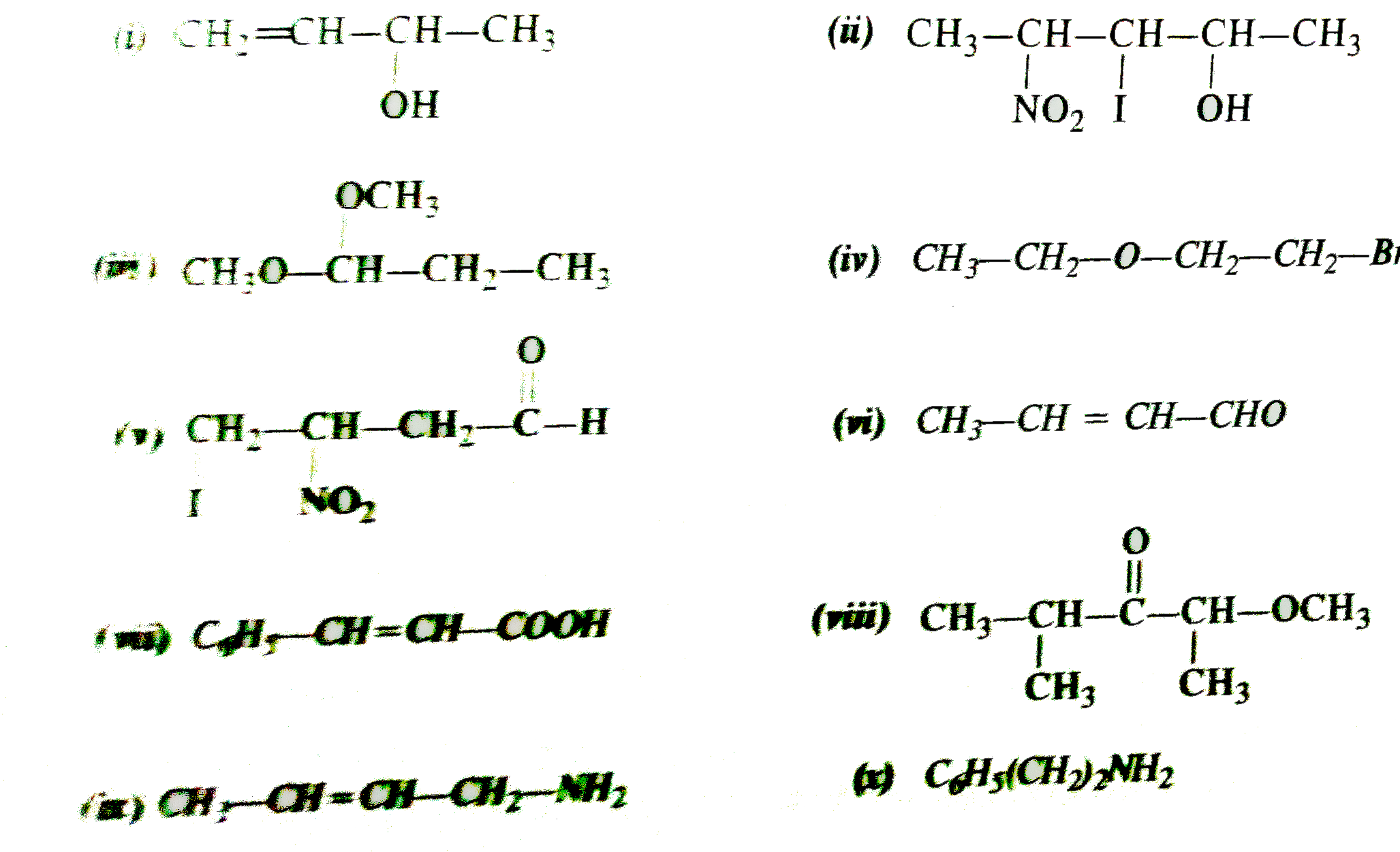

View SolutionDraw the structures of the following compounds.
(i) Hex-3-enoic acid, (ii) 2-chloro-2-methylbutan-1-ol
(iii) 5, 5-Diethylnonan-3-ol, (iv) Propane-1, 3-diamine
(v) 4-Nitropent-1-yne, (vi) But-2-ene-1, 4-dioic acid
(vii) 4-Amino-2-ethylpent-2-enal, (viii) Ethyl-3-methoxy-4-nitrobutanoate
(ix) 5-(1-Methylethyl)-3-methyloctane, (x) Hex-4-yn-2-one
(xi) Hepta-1, 4 -dien-3-ol, (xii) 4-Chloropent-2-ene
(xiii) 1-Phenylpropan-2-one, (xiv) 4-Ethyl-2, 6-dimethyldec-4-ene.
View SolutionWrite the IUPAC names of the following compounds.
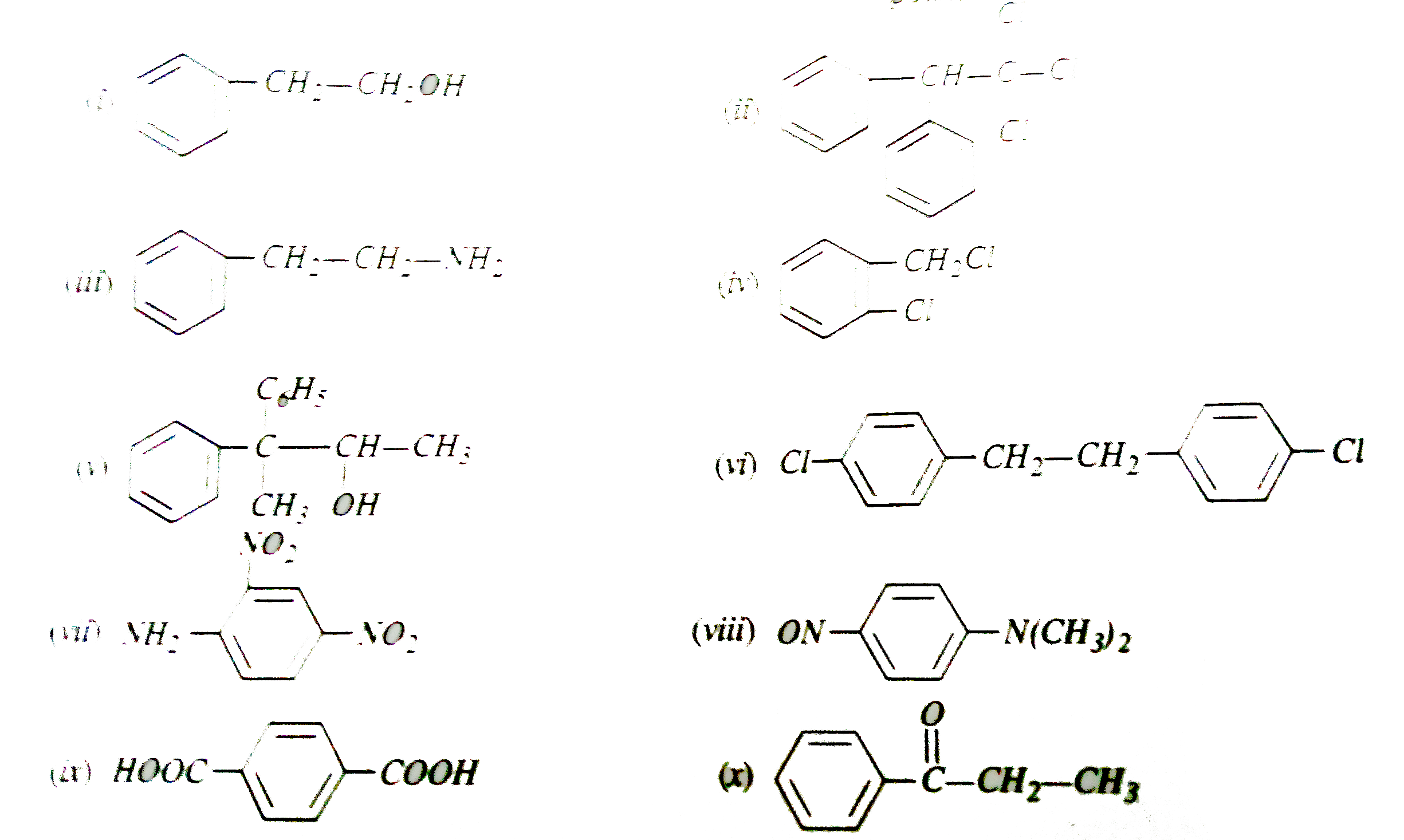
View SolutionGive the IUPAC names of the following :
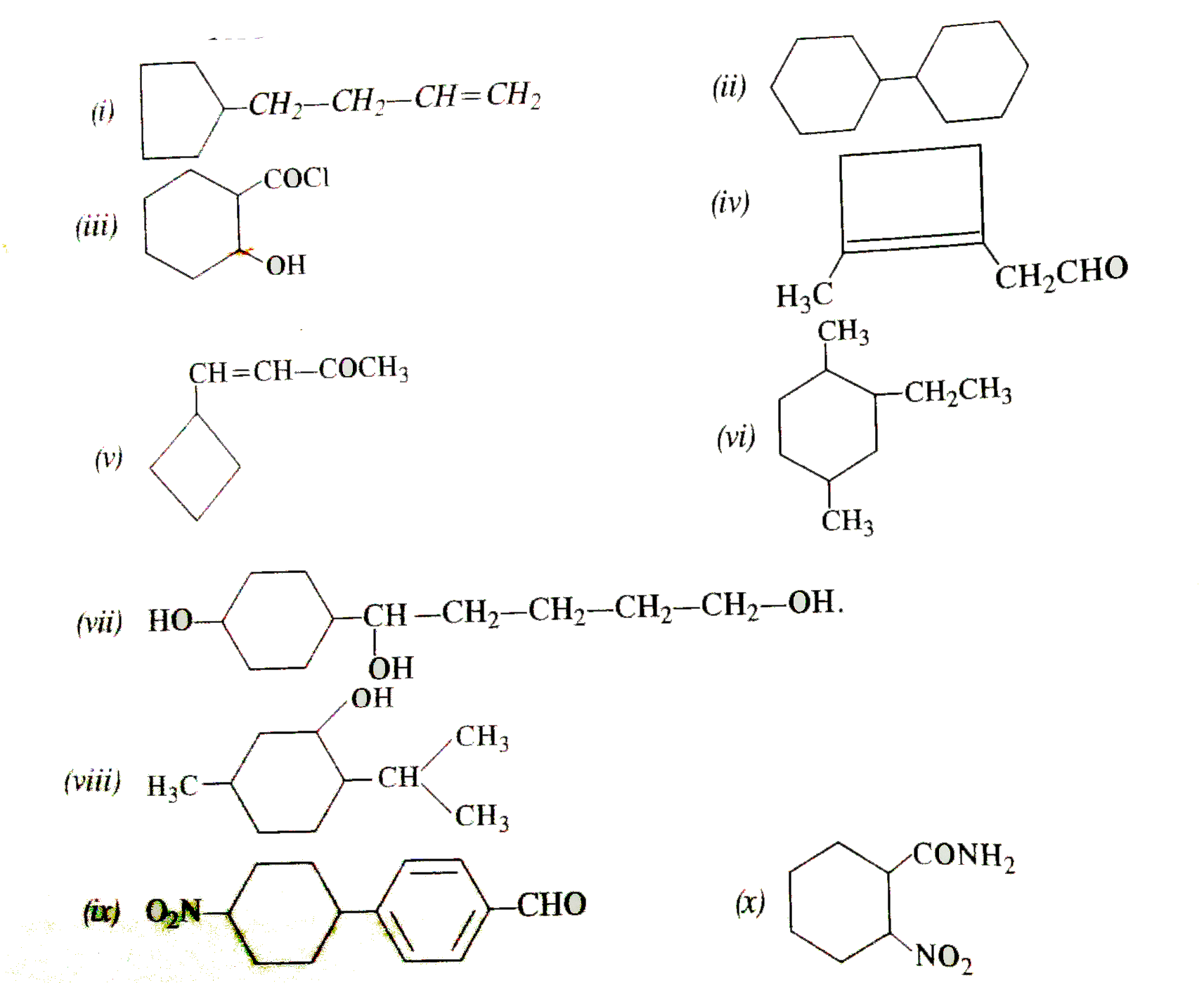
View SolutionGive the structural formula and IUPAC names of the following compounds.
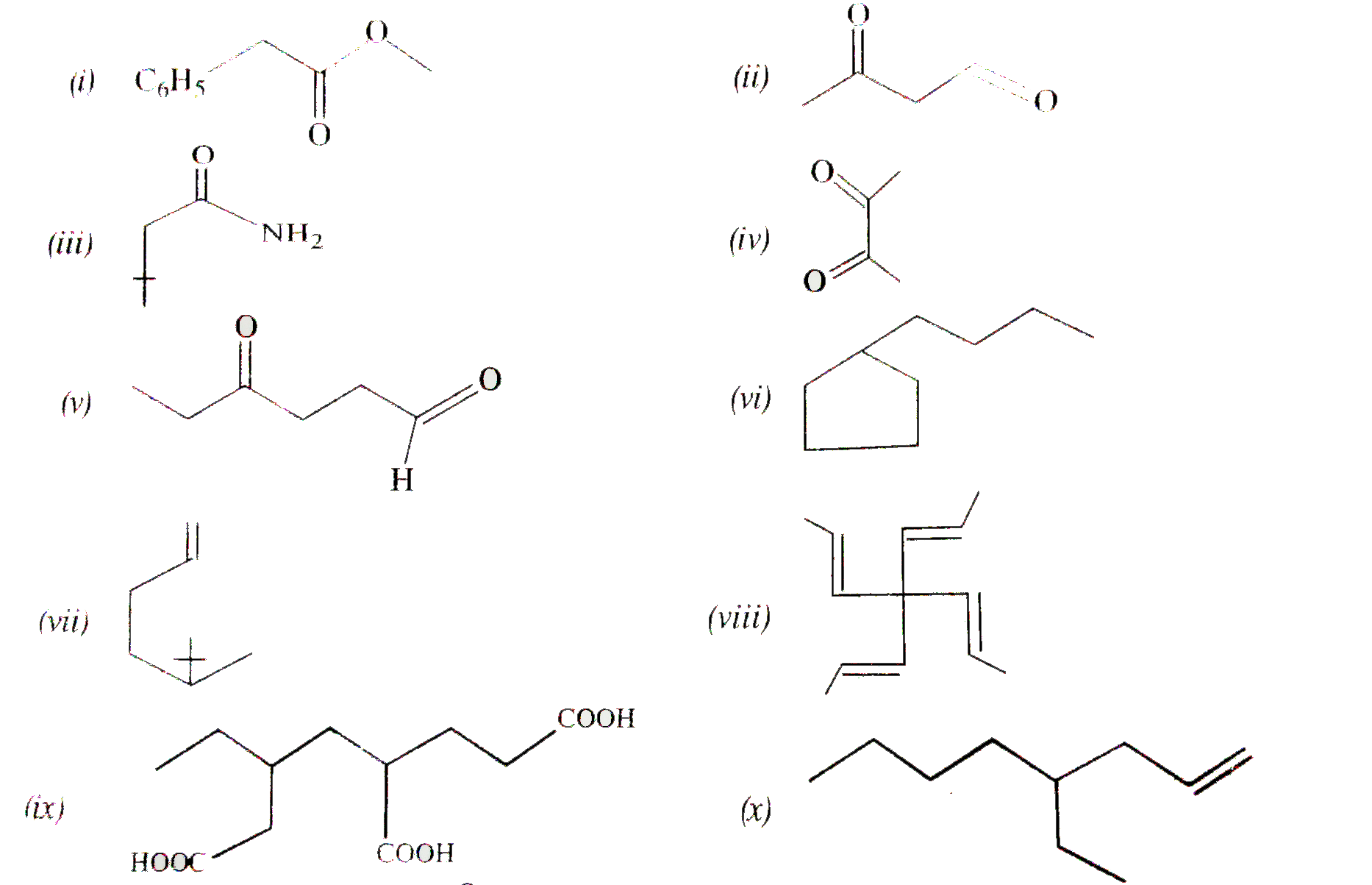
View SolutionWrite IUPAC names of the following compounds.
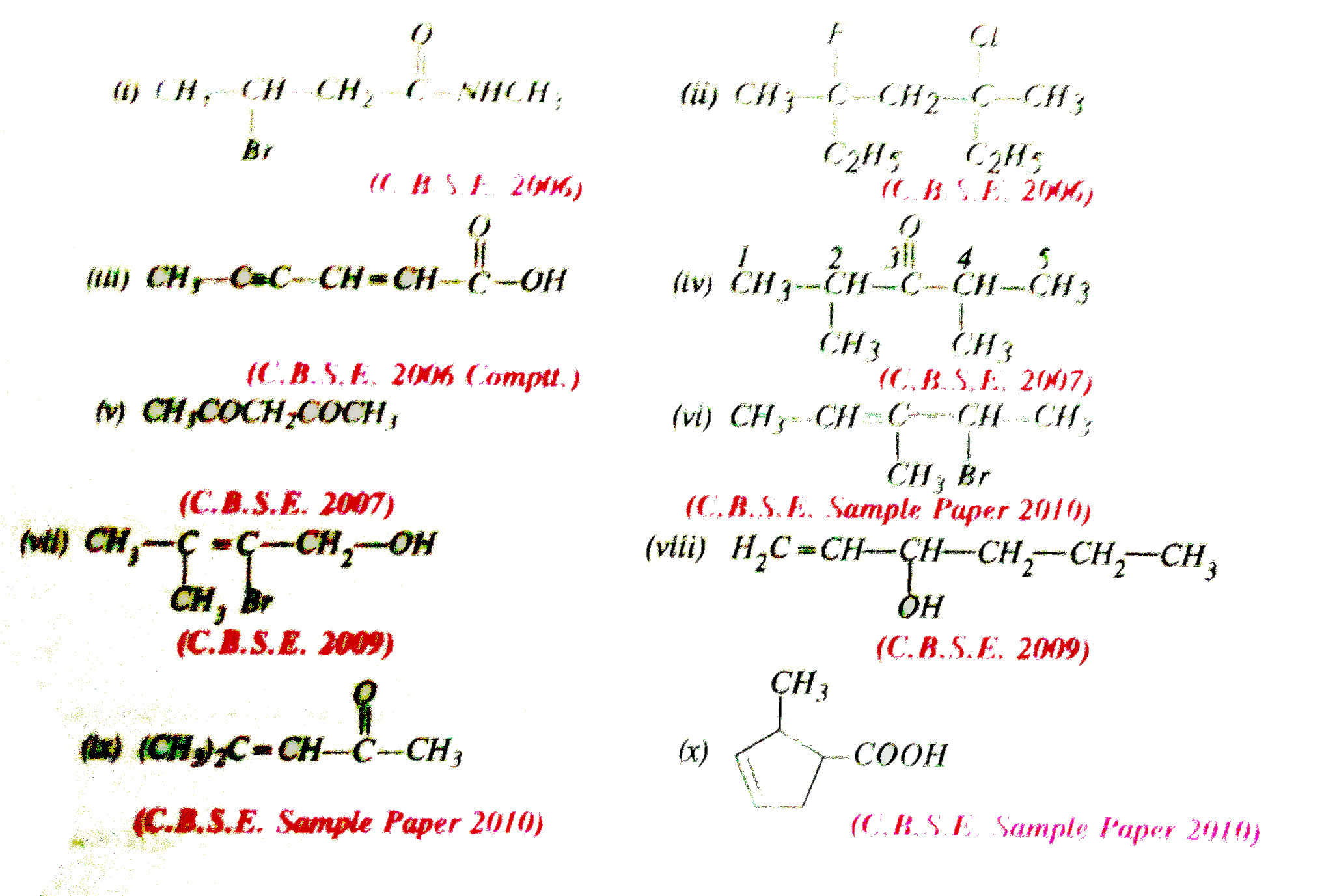
View SolutionWhich structural isomerism is exhibited by the following pairs :
(i) `CH_(3)-overset(O)overset("||")(C)-OH` and `H-overset(O)overset("||")(C)-O-CH_(3)`
(ii) `CH_(2) =CHOH` and `CH_(3)-overset(O)overset("||")(C)-H`
(iii) `CH_(3)-CH_(2)-CH=CH_(2)` and `CH_(3)-CH=CH-CH_(3)`
(iv) `CH_(3)-CH_(2)-CH_(2)-NH_(2)` and `CH_(3)-underset(NH_(2))underset("|")(CH)-CH_(3)`
View SolutionGive the structures and IUPAC names of all the isomeric monochlorobutane.
View SolutionWrite all the acyclic structural isomers with the molecular formula `C_(4)H_(10)O`. Give their IUPAC names also.
View Solution(a) Which of the following are position isomers ?
`{:((i)" "CH_(2)=CH" "(ii)" "CH_(3)-C-CH_(3)" "(iii)" "CH_(3)-CH=C-CH_(3)),(" |"" ||"" |"),(" "CH_(2)-CH_(3)" "CH_(2)" "CH_(2)):}`
(b) Write the IUPAC name of the functional isomer of `CH_(3)CH_(2)CH_(2)CH_(2)CHO`.
(c) Which type of structural isomerism is shown by the following pair of compounds ?
`{:(" "Br" "CH_(3)),(" |"" |"),(CH_(3)-CH-CHBr_(2) and Br_(2)CH-CH-Br):}`
View SolutionUsing curved arrow notation show the formation of reaction intermediates when the following covalent bonds undergo heterolysis.
(i) `H_(3)C-CH_(2)-Cl" "`(ii) `H_(3)C-C equiv N" "`(iii) `CH_(3)ONa`
View SolutionIdentify the electrophile centre in the following :
(i) `CH_(3)CHO" "`(ii) `CH_(3)CH=CH_(2)" "`(iii) `CH_(3)COCH_(3)`
View SolutionArrange the following resonating structures in order of increasing stability
`underset((I))(CH_(2)=overset(+)(N)=overset(-)(N))" "underset((II))(H_(2)overset(+)(C)=N=overset(-)(N))" "underset((III))(H_(2)overset(-)(C)-overset(+)(N) equiv N)" "underset((IV))(H_(2) overset(-)(C)-N=overset(+)(N))`
View SolutionArrange the following carbocations in increasing order of stability and mention basis of the order suggested.
(i) `overset(o+)(C)H_(3)" "`(ii) `CH_(3)overset(o+)(C)H_(2)" "`(iii) `CH_(3)overset(o+)(C)HCH_(3)" "`(iv) `CH_(3)-underset(CH_(3))underset(|)overset(o+)(C)-CH_(3)`
View Solutionwhen benzyl chloride is boiled with aqueous `KOH` solution and the solution is acidified by a few drops of dilute `HNO_(3)` followed by `AgNO_(3)` solution, a white precipitate is formed. However, no such precipitate is noticed when the reaction is carried with chlorobenzene. explain.
View Solution0.45 g of an organic compound when analysed by combustion gave 1.10 g carbon dioxide and 0.30 g water. Calculate the persentage of carbon and hydrogen in it.
View Solution0.20 g of an organic compound forms 0.5764 g of `CO_(2)` and 0.1512 g of water on combustion. Calculate the percentage of carbon and hydrogen in the compound.
View SolutionIn Duma's method 0.206 g of an organic compound gave `18.8 cm^(3)` of moist `N_(2)` at `17^(@)C` and 760 mm Hg pressure. If aqueous at `17^(@)C` is 14.5 mm Hg, calculate the percentage of nitrogen in the given organic compound.
View SolutionAn organic compound on analysis gave the following data:
(i). 0.25 gm of the compound on complete combustion gave 0.37 gm of `CO_2` and 0.2 gm of water.
(ii). 0.25 gm of the compound on analysis by Dumas method gave 32 ml of nitrogen gas at STP.
Calculate the percentages of `C,H,N` and `O `in the organic compounds.
View SolutionAmmonia produced when 0.75 g of a substance was kjeldahlised neutralised `30 cm^(3)` of 0.25 `NH_(2)SO_(4)`. Calculate the persentage of nitrogen in the compound.
View SolutionIn Kjeldahl's method, 0.4422 g of an organic compound was digested with conc. `H_(2)SO_(4)`. The ammonia evolved on distilling the resulting solution with excess of `NaOH` solution was absorbed in 50 mL of 1 N `H_(2)SO_(4)` solution. The residual acid required 65.5 mL of `N//2` alkali solution for complete neutralisation. Find the percentage of nitrogen in the given organic compound.
View Solution1.216 g of an organic compound was Kjeldahlised and the ammonia evolved was absorbed in 100 mL of 1-N `H_(2)SO_(4)`. The remaining acid solution was made upto 500 mL by dilution with water. 20 mL of this diluted solution required 32 mL of `N//10 NaOH` solution for complete neutralisation. calculate the percentage of nitrogen in the compound.
View Solution0.40 g of an organic compound gave 0.30 g of silver bromide by carius method. Determine the percentage bromine in the compound.
View SolutionIn an estimation od sulphur by carius method, 0.2175 g of a compound gave 0.5825 g of barium sulphate. Calculate the percentage of sulphur in the compound.
View Solution0.515 g of an organic compound containing phosphorus gave 0.214 g of magnesium pyrophosphate in Carius method for the estimation of phosphorus. Calculate the percentage of phosphorus in the given organic compound.
View SolutionIn determination by Victor Meyer method, 0.60 g of a volatile substance expelled 123 mL of air measured over water at `20^(@)C` and 757.4 mm pressure. Find the molecular mass of the substance. Aqueous tension at `20^(@)C` is 17.4 mm.
View Solution0.759 g of silver salt of a dibasic acid was ignited to form 0.463 g of the silver residue. Calculate the molecular mass of the acid.
View Solution0.532 g of the chloroplatinate of a diacid base gave 0.195 g of the platinum residue on ignition. Calaculate the molecular mass of the base.
View Solution0.075 g of a monobasic acid required 10 mL of `N//12 NaOH` solution for complete neutralisation. Calculate the molecular mass of the acid
View Solution7.5 g of an acid are dissolved per litre of the solution. 20 mL of this acid solution required 25 mL of `N//15 NaOH` solution for complete neutralisation. Calculate the equivalent mass of the acid.
View Solution
Example questions and complete solutions for chapter ORGANIC CHEMISTRY - SOME BASIC PRINCIPLES & TECHNIOUES of S DINESH & CO CHEMISTRY (HINGLISH) of Class 11
All Exercises from DINESH COMPANION CHEMISTRY Class 11 CHEMISTRY ORGANIC CHEMISTRY - SOME BASIC PRINCIPLES & TECHNIOUES
- Assertion-Reason
- ASSIGNMENT
- CONCEPT BASED QUESTION
- Detection & Estimation of Organic Compounds
- Example
- Matching Type
- MCQB
- MCQS
- N.C.E.R.T.
- NCERT Exemplar Problems
- Problems For Practice
- PURIFICATION & CHARACTERISATION OF ORGANIC COMPOUNDS
- Purification of Organic Compounds
- SHORT ANSWER TYPE QUESTION
- Some Basic Principles in Organic Chemistry
- VALUE BASED QUESTION